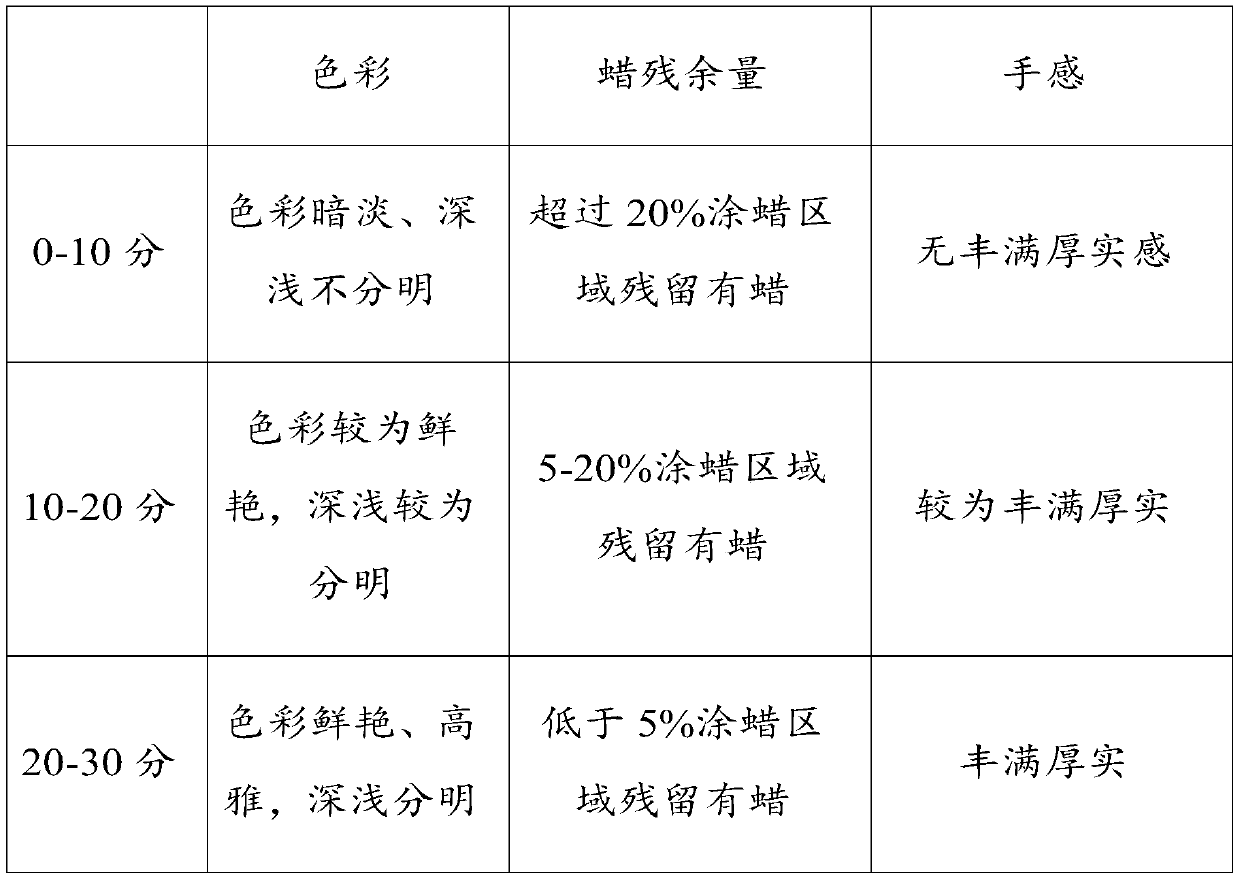Cotton Batik Method and Batik Cotton Cloth
A technology for batik and cotton cloth, applied in the field of batik, can solve the problems of rosin labor production environment pollution, difficulty in improving product quality, and inability to obtain wax pattern patterns, etc., and achieves the effects of facilitating later removal, improving environmental protection, and increasing plasticity
- Summary
- Abstract
- Description
- Claims
- Application Information
AI Technical Summary
Problems solved by technology
Method used
Image
Examples
Embodiment 1
[0040] A kind of batik cotton cloth, it is made by following method:
[0041] Put the cotton cloth into alkaline water and cook for 25 minutes, wash and dry for preliminary painting, then use wax to coat the unpainted area of the cotton cloth with wax, soak the waxed cotton cloth in a dyeing agent with a bath ratio of 1:50 at a temperature of 56°C After dyeing for 60 minutes, soak the dyed cotton cloth in water containing plant ash for 30 minutes, turn it over every 1 minute to remove the floating color, put it in the color fixing agent and boil it for 25 minutes, then rinse it with water, steam dewax it at 110 ℃, and then After two times of soaping at 45°C and two times of water washing at 25°C, the obtained product was dried.
[0042] Wherein, the wax includes honey wax, paraffin wax, amber and phthalates in a weight ratio of 50:20:4:1 in sequence. Alkaline water is obtained by the following method: burn plants with a water content of 8%, get plant ash and mix it with wat...
Embodiment 2
[0044] A kind of batik cotton cloth, it is made by following method:
[0045] Put the cotton cloth into alkaline water and cook for 20 minutes, wash and dry for initial painting, then apply wax to the unpainted area of the cotton cloth with wax, soak the waxed cotton cloth in the dyeing agent with a bath ratio of 1:20 at a temperature of 75°C After dyeing for 50-70 minutes, soak the dyed cotton cloth in water containing plant ash for 20 minutes, turn it over every 1 minute to remove the floating color, put it in the color fixing agent and soak it for 23 minutes, then rinse it with water, and steam dewax it at 95 ℃ , and then washed once at 25°C, and dried.
[0046] Wherein, the wax includes honey wax, paraffin wax, amber and phthalates in a weight ratio of 30:20:4:1 in sequence. Alkaline water is obtained by the following method: burn plants with a water content of 12%, get plant ash and mix it with water at a volume ratio of 1:10. The dyeing agent is obtained by natural f...
Embodiment 3
[0048] A kind of batik cotton cloth, it is made by following method:
[0049] Put the cotton cloth into alkaline water and boil for 15 minutes, wash and dry for preliminary drawing, then wax the unpainted area of the cotton cloth with wax, soak the waxed cotton cloth in the dyeing agent with a bath ratio of 1:35 at a temperature of 55°C After dyeing for 70 minutes, soak the dyed cotton cloth in water containing plant ash for 23 minutes, turn it over every 1 minute to remove the floating color, put it in the color fixing agent and soak it for 25 minutes, then rinse it with clean water, steam dewax it at 100 ℃, and then After two times of soaping at 45°C and two times of water washing at 25°C, the obtained product was dried.
[0050] Wherein, the wax includes honey wax, paraffin wax, amber and phthalates in a weight ratio of 45:13:2.5:1 in sequence. Alkaline water is made by the following method: burn plants with a water content of 8-12%, get plant ash and mix it with water a...
PUM
 Login to View More
Login to View More Abstract
Description
Claims
Application Information
 Login to View More
Login to View More - Generate Ideas
- Intellectual Property
- Life Sciences
- Materials
- Tech Scout
- Unparalleled Data Quality
- Higher Quality Content
- 60% Fewer Hallucinations
Browse by: Latest US Patents, China's latest patents, Technical Efficacy Thesaurus, Application Domain, Technology Topic, Popular Technical Reports.
© 2025 PatSnap. All rights reserved.Legal|Privacy policy|Modern Slavery Act Transparency Statement|Sitemap|About US| Contact US: help@patsnap.com

